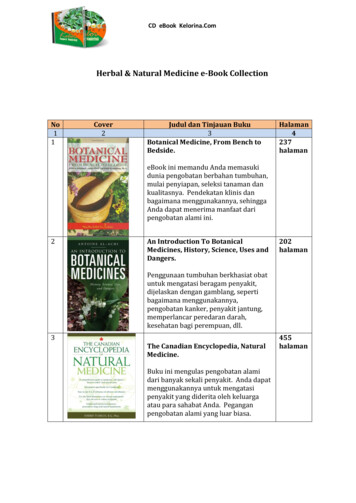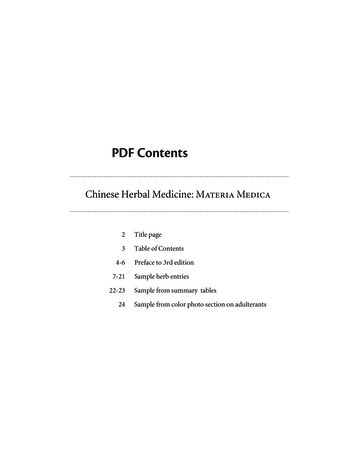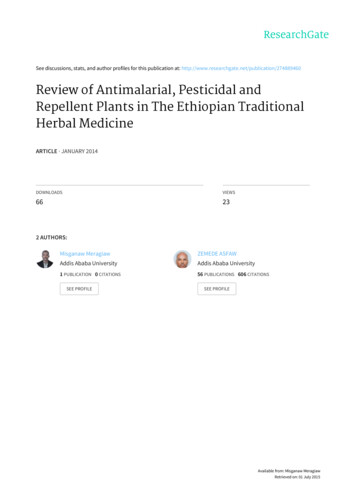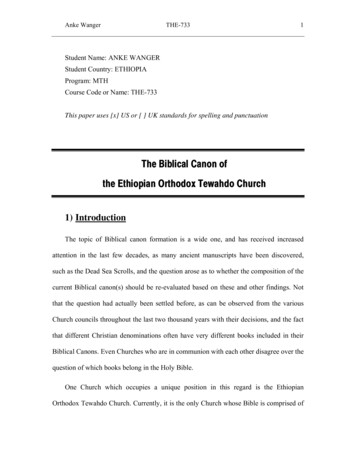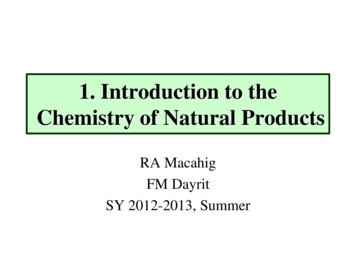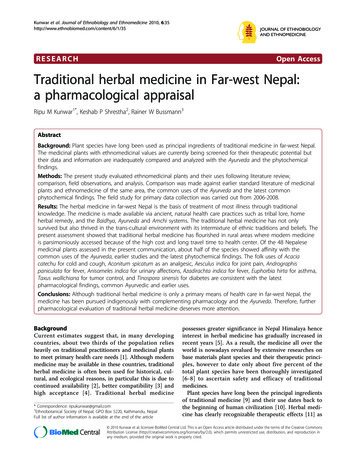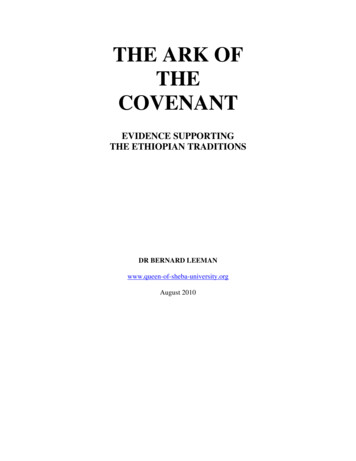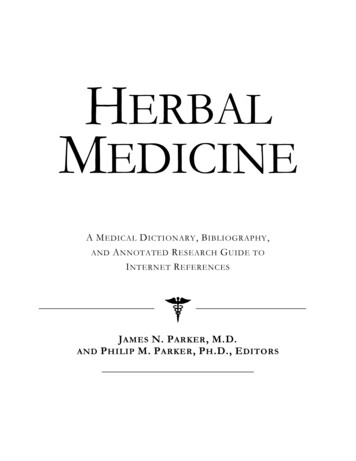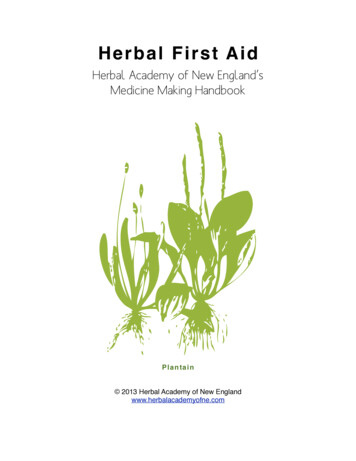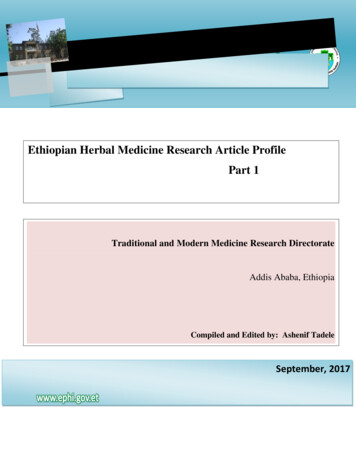
Transcription
Ethiopian Herbal Medicine Research Article ProfilePart 1Traditional and Modern Medicine Research DirectorateAddis Ababa, EthiopiaCompiled and Edited by: Ashenif TadeleSeptember, 2017
Ethiopian Herbal Medicine Research ProfileContentsINTRODUCTION . 3Rationale for Development of Herbal Remedies . 5Up to 1990 . 61991 . 121992 . 141993 . 151994 . 181995 . 201996 . 211998 . 231999 . 252000 . 312001 . 342002 . 432003 . 522004 . 632005 . 672006 . 852007 . 982008 . 1162009 . 1262010 . 1412011 . 1602012 . 1782013 . 1942014 . 2402015 . 294Annex I Researched Medicinal Plants . 335Ethiopian Public Health InstitutePage 2
Ethiopian Herbal Medicine Research ProfileINTRODUCTIONPlants have been used as medicinal sources since ancient times, and even today, plant basedpharmacopoeias continue to play an essential role in world health care. The use of biologicalresources for various therapies has been documented in many different parts of the world,especially in remote regions where traditional medicines provide an alternative to "modern" healthcare system this perhaps may be sequel to the inability of orthodox medicine to comprehensivelyaddress most disease conditions plaguing mankind. The World Health Organization estimated that80% of the world population relies on traditional medicine prepared mainly by the use of naturalproducts (animals and plants) to meet their daily health requirements. WHO estimates that of the35, 000 – 70,000 species of plants that are used for medicinal purposes around the world, medicinalplants also play a major role and constitute the backbone of TM (Traditional System of medicine)practices. Hence, developing countries should endeavour to develop and utilize local medicationsthat are most appropriate to their local circumstances especially for Primary Health Care (PHC) inorder to cut down on huge cost associated with incessant drug importation.Ethiopia is a centre of diversity for a number flora and fauna the sixth centers of biodiversity inthe world. The country is endowed with rich flora, having more than 6,500 species of vascularplants out of which an estimated 12% are endemic and about 887 species are used as medicinalplants. The majority (80%) of Ethiopian people depends on traditional medicine for their healthcare, and more than 95% of traditional medicinal preparations made from plant origin. Ethiopia isalso a home for many languages, cultures and beliefs that have in turn contributed to the highdiversity of traditional knowledge and practice of the people, which, among others include the useof medicinal plants.Herbal medicine in the simplest form are medicines or drugs made from herbs or plants and canbe said to process several synonyms all of which refer to plants as the raw materials for medicinenamely, phytomedicines, plant medicines, green medicines, traditional medicine portions,traditional remedies plant drugs and forest health products among others [6]. The World HealthOrganization also defined herbal medicine as finished labeled medicinal products that contain asactive ingredients aerial or underground parts of plants or other plant materials or combinationsthereof whether in crude juices, gums and fatty oils and other substances of this nature. HerbalEthiopian Public Health InstitutePage 3
Ethiopian Herbal Medicine Research Profilemedicine may contain standard excipients in addition to the active ingredients. Medicinescontaining plant material combined with chemically defined active substances includingchemically defined isolated constituents of plants are not considered to be herbal medicine.Exceptionally, in some countries herbal medicine may also contain by tradition, natural organic orinorganic active ingredients which are not or plant origin.Through technological Research and Development, countries of the Far East Asia such as China,South Korea and India have been able to have been able to meet 75% of their health care needsthrough the development and utilization of herbal medicine and traditional medicine practice.China for instance is the World leading producer and exporter of herbal medicine. The annualindustrial output for China In 1993 amounted to 2.5 billion and reached to 47.84 billion in 2010,up 29.5% from the previous year with a total profit of nearly 4.52 billion in 2010.Complementary/alternative medicine sales in Australia totaled US 1.12 billion in 2008.10 InJapan, herbal medicine sales reached to US 1.47 billion in 2008, in republic of Korea whereannual expenditures on traditional medicine were US 4.4 billion in 2004, rising to US 7.4 billionin 2009.The main aim of this document is to show the research profile of Ethiopian traditional medicinesup to 2015 from published scientific studies in Ethiopia .Ethiopian Public Health InstitutePage 4
Ethiopian Herbal Medicine Research ProfileRationale for Development of Herbal RemediesOver the past 100 years, the development and mass production of chemically synthesized drugshave revolutionized health care in most parts of the word. However, large sections of thepopulation in developing countries still rely on traditional practitioners and herbal medicines fortheir primary care. In Africa up to 90% and in Ethiopia 80% of the population depend on traditionalmedicine to help meet their health care needs.Herbal medicine has been commonly used over the years for treatment and prevention of diseasesand health promotion as well as for enhancement of the span and quality of life. Plants and naturalsources form the basis of today’s modern medicine and contribute largely to the commercial drugpreparations manufactured today, about 25% of drugs prescribed worldwide are derived fromplants such as atropine, morphine, quinine, ephedrine, warfarin, aspirin, digoxin, vincristine, taxol,and hyoscine.However, there is a lack of a systematic approach to assess their quality, safety and effectiveness.The holistic approach to health care makes herbal medicine very attractive to many people, but italso makes scientific evaluation very challenging because so many factors must be taken intoaccount. Herbal medicines are in widespread use and although many believe herbal medicines aresafe, they are often used in combination and are drawn from plant sources with their ownvariability in species, growing conditions, and biologically active constituents. Herbal extractsmay be contaminated, adulterated, and may contain toxic compounds. The quality control of herbalmedicines has a direct impact on their safety and efficacy. But, there is little data on thecomposition and quality of most herbal medicines, lack of adequate or accepted researchmethodology for evaluating traditional medicine.Research is needed for screen out bioactive compounds, assuring the quality, safety, moleculareffects, and clinical efficacy and development new products of the numerous herbs in commonusage, providing training on traditional medicine and providing information and education of thecommunity for improving their health care.Ethiopian Public Health InstitutePage 5
Ethiopian Herbal Medicine Research ProfileUp to 19901. Pankhurst R. The history and traditional treatment of smallpox in Ethiopia. Med Hist1965;9:343-346.2. Pankhurst R. An historical examination of traditional Ethiopian medicine and surgery. EthMed J. 1965;3(4):157-72.3. Pankhurst R (1965) The history and traditional treatment of rabies in Ethiopia. Med Hist9: 343-355.4. Pankrust R: Historical reflections on the Traditional Ethiopian Pharmacopoeia. J EthiopPharm Assoc 1976, 2:29-335. Berhane-Selassie, T. 1971. An Ethiopian Medical Text Book written by GerazmachGabrawald Aragahan, Daga Damot. Addis Abeba University, Institute of EthiopianStudies. Addis Abeba.6. Abate, G. B., T. Gebre Egziabher & M. Tadesse. 1976. A study on the medicinal plantsof Ethiopia, Unpublished. Science Faculty, Addis Abeba University.7. Kloos, H. 1976. Preliminary studies of medicinal plants and plant products in marketsof central Ethiopia. Ethnomedicine 4:63-102.8. Tewolde-Berhan Gebre-Egziabher, Gelahun Abate and Mesfin Tadesse, 1976. A Study oftheMedicinal Plants of Ethiopia, Part 1. Department of Biology, Addis Ababa University(mimeographed, in Amharic).9. Kloos, H., A. Tekle, L. Yohannes, A. Yosef & A. Lemma. 1978. Preliminary studies oftraditional medicinal plants in nineteen markets in Ethiopia: use patterns and publichealth aspects. Ethiopian Medical Journal 16:33-43.10. Abegaz, B. and Dagne, E. (1978), Comparative bioassay studies of some traditionalanlhelmintic plants, plant extracts and modern drugs. SINET: Ethiop.J.Sci 1(2): 117- 121.11. Tsega, E., Landells, J., Teklehaimanot, R., Berkassa, T., Tessema, D. (1978), Kossotoxicity in mice. SINET: Ethiop.J.Sci 1(2): 99-10612. Slikkerveer LJ.Rural health development in Ethiopia. Problems of utilization oftraditional healers.Soc Sci Med 1982;16(21):1859-72.AbstractEthiopian Public Health InstitutePage 6
Ethiopian Herbal Medicine Research ProfileIn Ethiopia, a pluralistic complex of multiple and simultaneous medical care utilization hasconstituted the Ethiopian variant of medical pluralism in East Africa, where through a process ofacculturation, Cushitic, Arabic and Amharic medical traditions co-exist with cosmopolitanmedicine. On request of the central government, joint medical-sociological and anthropologicalresearch between in Universities of Addis Ababa and Leiden was conducted in the EasternHighlands with the main objective to formulate recommendations for the improvement andextension of the health care facilities in the rural areas. The situational analysis revealed relativelylow utilization rates of the "official' health services by the local population. Consequently a desirewas expressed to undertake health services development research, particularly centered upon thefunctioning of the various medical systems and sub-systems in Hararghe. In order to assess theoverall pattern of illness behaviour special consideration was given to the question "when, and towhat extent do people use the available medical systems?". After the completion of the subsequentsubjective and objective health surveys the concept of "distance reduction' between provider andconsumer of health care was introduced in order to increase the utilization of the formal healthservices, taking into account the problems related to geographical, economic and socio-culturaldistance. In this paper, a description will be given of the existing alternative health care resources.In addition, the positive contribution which the concept of medical pluralism could provide to ruralhealth planning will be examined within the context of the research project. This will include adiscussion of the problems encountered in connection with the utilization of traditional healers andthe possibilities for their incorporation into a future syncretic type of national health care deliverysystem.13. Berhanu Abegaz and P.G. Yohannes, 1982. Constituents of the essential oil of Artemisiarehan. Phytochemistry, 21: 1791-1793.14. Yohannes, P.G., and Dagne, E. (1983), Comparative study of male and female flowers ofHagenia abyssinica Gmel. SINET: Ethiop.J.Sci 6(1): 31-3415. Legasse wolde Yohannis (1983) Past and on growing agro botanical studies of Endod inEthiopia.16. Abebe W.Traditional pharmaceutical practice in Gondar region, northwesternEthiopia.J Ethnopharmacol. 1984 Jun;11(1):33-47.Ethiopian Public Health InstitutePage 7
Ethiopian Herbal Medicine Research ProfileAbstractThe knowledge and skills of Ethiopian traditional healers in Gondar region on the pharmaceuticalaspects of their practice were assessed using a questionnaire. Of the 86 healers interviewed, only83 gave responses good enough to be considered in the analysis of results. It was shown that thehealers obtained their drugs mainly from natural substances and these in descending order offrequency were plants, animals and minerals. The healers prepared the drugs in various dosageforms including liquids, ointments, powders and pills. They also prescribed drugs in a "nonformulated" form. They usually incorporated additives and more than one drug in a single dosageform. Drugs were administered using eight routes, the main ones being, topical, oral andrespiratory. Most of the healers claimed to determine doses and to know about side-effects ofdrugs. When side-effects became severe, "antidotes" were claimed to be used. The healers imposedrestriction when certain types of drugs were taken by patients. Most of them stored the drugs thatshould not be dispensed immediately after collection or preparation. Drugs were usually stored incontainers such as bottles, papers, pieces of cloth, leaves and horns, and were kept anywhere athome. The results are discussed mainly in relation to modern pharmaceutical and medical practicesand their importance to health care services among the people in Gondar region is also stated.17. Asres K, Phillipson JD, Mascagni P. Two novel minor alkaloids from EthiopianCalpurnia aurea Ssp. aurea. Planta Med. 1986 Aug;(4):302-4.AbstractTwo novel minor quinolizidine alkaloids 4 beta-hydroxy-13alpha- O-(2'-pyrrolylcarbonyl)lupanine (digittine) and its amino alcohol, 4 beta, 13alpha-dihydroxylupanine, have been isolatedfrom Ethiopian Calpurnia aurea ssp. aurea. The structures of these alkaloids were determined bychemical transformation and by means of spectroscopic techniques (UV, IR, CD, MS, (1)H-NMRand (13)C-NMR) including two dimensional NMR.18. Abebe, W. 1986. A survey of prescriptions used in traditional medicine in GondarRegion, Northwestern Ethiopia: General pharmaceutical practice. Journal ofEthnopharmacology 18:47-165.Ethiopian Public Health InstitutePage 8
Ethiopian Herbal Medicine Research ProfileAbstract : No19. Abebe D: Traditional medicine in Ethiopia: the attempts being made to promote it foreffective and better utilization. SINET Ethiopia J. Sci 1986, 9:61-69.20. Tadesse, M. (1986), Some Medicinal plants of Central Shoa and South-Western Ethiopia,SINET: Ethiop.J.Sci., 9 (Suppl): 143-167.21. Kloos H, Etea A, Degefa A, Aga H, Solomon B, Abera K, Abegaz A, Belemo G. Illnessand health behaviour in Addis Ababa and rural central Ethiopia.Soc Sci Med.1987;25(9):1003-19.AbstractThis paper examines the results of health surveys among 544 randomly selected households (2829people) in seven kebele (urban dwellers' associations) in Addis Ababa and Kaliti, an industrialsuburb of Addis Ababa, and in four rural villages in two peasant associations. The major objectivewas to study illness distribution and health behaviour among different socioeconomic and culturalgroups in urban and rural communities within the context of available health resources, nationalhealth policy and planning. Results show that in spite of the rapid expansion of health servicessince the Ethiopian revolution serious problems of allocation and access persist. Higher illnessprevalance rates were found in rural areas (23.2%), Kaliti (25.5%) and in the low socioeconomickebele in Addis Ababa (23.9%) than in the high socioeconomic kebele (16.5%), but rural/urbanand intraurban differences were greater than reported here due to underreporting. One-third of allillnesses were treated by modern services, 19.9% by self care and 26.0% by traditional medicineand transitional healers, with 21.5% of all illnesses not being treated. Utilization rates varied withtype and duration of illness, socioeconomic level, age, sex and place of residence. The role ofdistance and other contact barriers, treatment outcome and availability of private clinics andalternative health resources in utilization is also evaluated. Coverage of the modern health serviceswas associated with socioeconomic status and mobility of patients as well as availability of healthservices.Ethiopian Public Health InstitutePage 9
Ethiopian Herbal Medicine Research Profile22. Ayehu, A. 1987. Metsihafe Ise-Hiywot. (A compendium of herbal letters compiledand translated into Amharic by a prominent traditional religious Debterra: AhaduAyehu), Addis Abeba University23. Bishaw, M. 1988. Integrating Indigenous and Cosmopolitan Medicine in Ethiopia.Southern Illinois University, Carbondale, Illinois.24. Negussie B. Traditional wisdom and modern development: A case study of traditional perinatal knowledge among women in southern Shewa, Ethiopia. Doctoral dissertation,University of Stockholm, December 1988.25. Abate, G. (1989), Etse Debdabe, Research and Publication office, Addis Ababa University,Addis Ababa, Ethiopia.26. obiomedicalpractice. Ethiopian J Health Dev.1989;3:75–89.27. Schneider P, Shewangizaw E, Taye E, Gebrehiwot T, Worku S, Oppermann J, Leupold W,Teka T. Traditional medicine in Ethiopia in childhood diseases. Kinderarztl Praxis1989;57(8):393-9.28. Bishaw M.Attitudes of modern and traditional medical practitioners towardcooperation. Ethiop Med J 1990 Apr;28(2):63-72.AbstractBetween 1985 and 1987 a total of 103 modern and 91 traditional medical practitioners wereinterviewed in seven towns in northwestern and central Ethiopia. The main aim was to assess theirattitudes toward the legitimacy of each other's medical system and, especially, toward the questionof cooperation or integration between modern and traditional medicine. It was found that themajority of the two groups of health workers believed that cooperation between the two systemsof medicine would be useful and that they themselves would be willing to participate in suchEthiopian Public Health InstitutePage 10
Ethiopian Herbal Medicine Research Profilecooperative efforts. Those willing to cooperate suggested that traditional healers be (1) broughtinto the existing, official health-care settings, (2) given regular government wages for theirservices, and (3) guided and supervised by their modern counterparts.29. Elmi, A.S., (1990), Research into medicinal plants: The Somali Experience. In:Proceedings of International Conference on Traditional Medicinal Plants, Mshigeni, K.E.,Nkuanya, M.H.H., Fupi, V., Mahunnah, R.L.A., Mshiu, E.N. (Eds), Arusha, Tanzania, pp.27-32.30. Mesfin Tadesse and Berhanu Abegaz, 1990. A revision of the genus Echinops (Compositae– Cardueae) in Ethiopia with notes on phytogeography and chemistry. In: Ihlenfeldt, H.D. (ed.), Mitt. Inst. Allg. Bot. Hamburg, Band 23b S: 605-629.31.Ethiopian Public Health InstitutePage 11
Ethiopian Herbal Medicine Research Profile199132. Bishaw M. Promoting traditional medicine in Ethiopia: a brief historical review ofgovernment policy.Soc Sci Med. 1991;33(2):193-200.AbstractPast and current official policy toward Ethiopian traditional medicine is reviewed. To facilitate theobjective assessment of official policy, the nature and historical origins of Ethiopian traditionalmedicine is examined briefly. It is noted that there is no single system of traditional medicine inEthiopia, even though themes that are common to the many cultural groups constituting the societyhave been evolving. Common to most systems of Ethiopian traditional medicine are theinterdigitation of 'mystical' and 'natural' explanations of ill-health and other misfortune and theholistic approach employed in dealing with illness and other personal misfortune. It is also notedthat since the 1974 change of government in Ethiopia, official attitude toward the promotion anddevelopment of traditional medicine appears to have become more positive, especially, after theadoption of the Primary Health Care strategy in 1978. While this is true as far as official statementsare concerned, in actual practice there continues to be considerable uncertainty about theinterpretation and implementation of Government policy. It is suggested that misconceptionsregarding the nature and role of traditional medicine in Ethiopian society will have to be correctedif appropriate plans and strategies are to be formulated.33. Abebe, D. & E. Hagos. 1991. Plants as a primary source of drugs in traditional healthpractices of Ethiopia. Pp. 101-113 in Plant Genetic Resources of Ethiopia. Edited byJ.M.M. Engels J. G. Hawkes & M. Worede. Cambridge University Press, Cambridge.34. Bishaw, M. 1991. The role and status of women in traditional health care services inEthiopia. Gender Issues in Ethiopia November 1991:55-65.35. J. M. M. Engels, J. G. Hawkes, M. Worede Plant Genetic Resources of EthiopiaCambridge University Press 1991Ethiopian Public Health InstitutePage 12
Ethiopian Herbal Medicine Research Profile36. Abebe D, Hagos E (1991): Plants as a primary source of drugs in the traditional healthpractices of Ethiopia. In: Plant Genetic resources of Ethiopia. Eds: Engles J, Hawkes J,Worede M. Cambridge: Cambridge University Press, 101-113.37. Hymete, A. and Kidane, A. (1991) Screening for Anthelmintic Activity in Two Echinopsspp. Ethiop. The Pharmaceutical Journal, 9, 67-71.38. Berhanu M. Abegaz, Mesfin Tadesse and Majinda, R., 1991. Distribution of sesquiterpenelactones and polyacetylenic thiophenes in Echinops (Compositae). BiochemicalSystematics and Ecology, 19(4): 323 - 328.39. Jacobsson L, Merdasa F. Traditional perceptions and treatment of mental disorders inwestern Ethiopia before the 1974 revolution. Acta Psychiatr Scand 1991;84(5):475-81.40.Ethiopian Public Health InstitutePage 13
Ethiopian Herbal Medicine Research Profile199241. Asres, K., Murthy, P.N., Djote, M. (1992), Antimicrobial Screening of CalotropisProcera, Calpurnia aures and Melia azedarach growing in Ethiopia, Ethiop.Pharm J.,10(1): 43-4942. Tadesse, M. & S. Demissew. 1992. Medicinal Ethiopian plants: Inventory, identificationand classification. Botany 2000: East and Central Africa NAPRECA Monograph 5:1- 19.43. Asres, K., Murthy, P.N., Djote, M. (1992), Antimicrobial Screening of Calotropis Procera,Calpurnia aures and Melia azedarach growing in Ethiopia, Ethiop.Pharm J., 10(1): 43-4944. Anokbongo WW. The role of African traditional medicine in health-care deliveryalongside modern medicine. In: Edwards S and Asfaw Z. eds. Plants used in Africantraditional medicine as practiced in Ethiopia and Uganda. Botany 2000: East and CentralAfrica. NAPRECA Monograph Series No. 5. Addis Ababa: NAPRECA & Addis AbabaUniversity, 1992;25-35.45. Mesfin Tadesse and Sebsebe Demissew, 1992. Medicinal Ethiopian Plants:Inventory,Identification and Classification. In: Sue Edwards & Zemede Asfaw, (eds.). Plants Used inAfrican Traditional Medicine as Practiced in Ethiopia and Uganda. Botany 2000: East andCentral Africa. NAPRECA Monograph Series No. 5: 1-24.46.Ethiopian Public Health InstitutePage 14
Ethiopian Herbal Medicine Research Profile199347. Tadesse A, Gebre-Hiwot A, Asres K, Djote M, Frommel D.The in-vitro activity ofVernonia amygdalina on Leishmania aethiopica. Ethiop Med J. 1993 Jul;31(3):183-9.AbstractAnti-leishmanial activity of chloroform and methanol extracts of Vernonia amygdalina, a plantwidely used in Ethiopia for the treatment of parasitic infections, has been assessed in vitro onLeishmania aethiopica. Amastigotes were more sensitive to V. amygdalina than promastigotes.The chloroform extract had a stronger parasiticidal activity, with median effective doses (ED50)of 18.5 micrograms/ml and 13.3 micrograms/ml for promastigotes and amastigotes, than themethanol extract with ED50 of 74.4 micrograms/ml and 45.8 micrograms/ml respectively.Cytotoxicity caused by V. amygdalina to host cells, the human leukaemia monocyte THP-1 cellline, as determined by the methyl tetrazolium assay, resulted in a median lethal dose (LD50) of19.6 micrograms/ml for the chloroform extract and 243.4 micrograms/ml for the methanol extract.In comparison, the ED50 and LD50 of pentamidine, a standard anti-leishmanial drug, were 0.5micrograms/ml and 1.4 micrograms/ml respectively. These results indicate that V. amygdalinadisplays potent anti-leishmanial activities and warrants further investigation.48. Desta B. Ethiopian traditional herbal drugs. Part II: Antimicrobial activity of 63medicinal plants.J Ethnopharmacol. 1993 Jun;39(2):129-39.AbstractA total of 315 extracts/fractions from 63 traditionally used Ethiopian plants were subjected toantimicrobial screening using known strains of Staphylococcus aureus, Salmonella gallinarum,Escherichia coli, Proteus vulgaris, Pseudomonas aeruginosa, Klebsiella pneumoniae and Candidaalbicans. The agar plate well-diffusion method was used at a sample concentration of 1000micrograms/ml; it was found that all of the plants showed activity against one or more of themicroorganism(s). Direct aqueous extracts from six plants were found to be active against all ofEthiopian Public Health InstitutePage 15
Ethiopian Herbal Medicine Research Profilethe test organisms. These findings confirm traditional therapeutic claims for aqueous dosage formsof these herbs. The relative susceptibility of the test organisms to the five types of extracts/fractionsindicated a decreasing rank order of: S. aureus, P. aeruginosa, C. albicans, S. gallinarum, E. coli,K. pneumoniae and P. vulgaris.49. Abebe, D. & A. Ayehu. 1993. Medicinal Plants and Enigmatic Health Practices inNorthern Ethiopia. World Health Organization, Ethiopian Ministry of Health Project No.AF/ ETH/TRM/001RB and the United Nations Development Programme.Abstract: No50. Tadesse, M. & S. Demissew. 1992. Medicinal Ethiopian plants: Inventory,identification and classification. Botany 2000: East and Central Africa NAPRECAMonograph 5:1- 19.Abstract: No51. Petros, B., Sorsa, S., Balcha, F. and Bogale, M. (1993), An in vitro screening of someEthiopian traditional medicinal plants against Plasmodium falciparum, In: FifthNAPRECA symposium on Natural products, Antananarivo, Madagascar.52. Abebe D, Ayehu A: Medicinal Plants and Enigmatic Health Practices of Northern Ethiopia.Addis Ababa: BSPP; 1993.53. Gebre-Mar
The holistic approach to health care makes herbal medicine very attractive to many people, but it also makes scientific evaluation very challenging because so many factors must be taken into account. Herbal medicines are in widespread use and al
